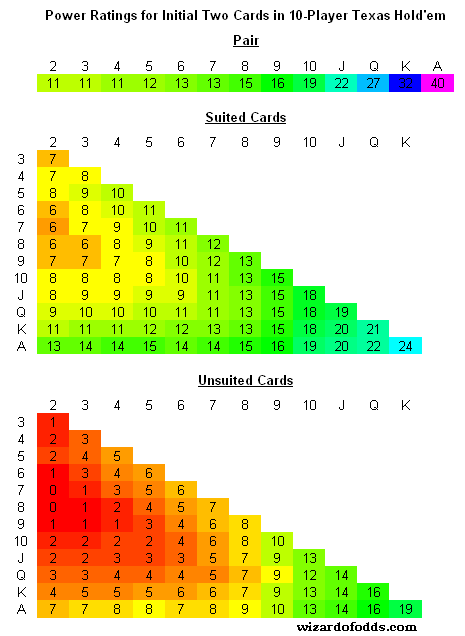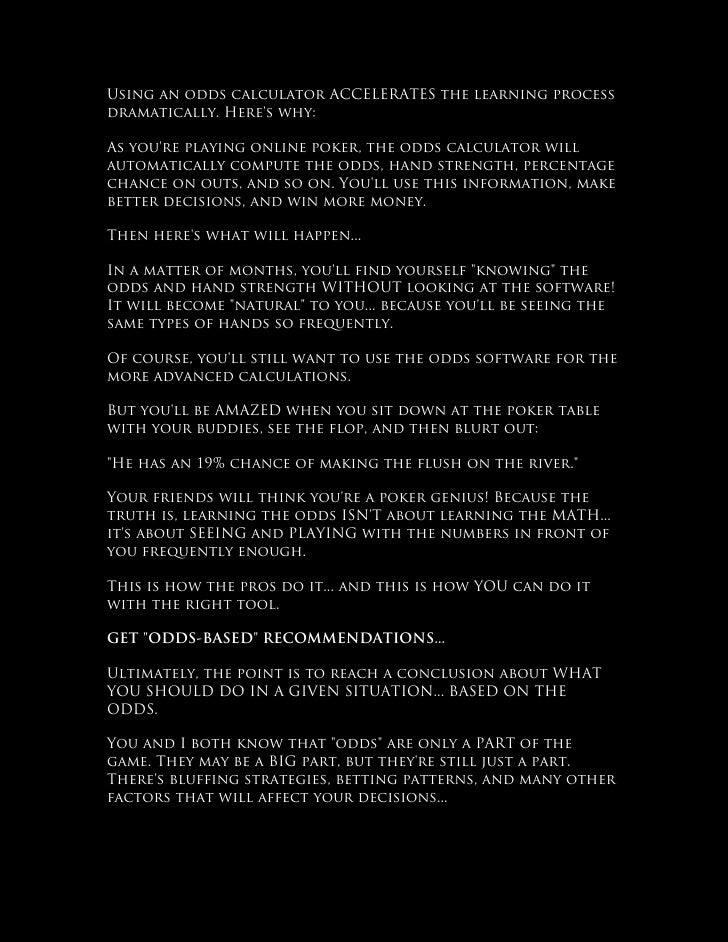— Improving any pocket pair to trips on the flop — 12 percent (one in eight). If you don't make trips on the flop, there's a 9 percent (one in 11) chance of doing so on the turn and river cards. Flopzilla is a poker calculator that has been designed to let you quickly and easily figure out how a range hits a board. Just enter a preflop range and a board and Flopzilla will work out for you how often that range hits hands like top pair, middle pair, a flushdraw, a gutshot, etc.
- Texas Holdem Flop Odds Calculator Game
- Texas Holdem Flop Odds Calculator Free
- Texas Holdem Flop Odds Calculator Yahoo
No longer available. Use PokerStove instead.
How to use the poker odds calculator.
1] Choose Player 1's and Player 2's holecards by clicking the card choices in the bottom section. The cards will be input into the calculator from left to right, so your first two choices will be Player 1's cards, and your second two choices will be player 2's cards.
2] The suit of the cards can be changed via the small box in the bottom left-hand corner of the Texas Holdem odds calculator.
3] If you do not want to see the pre-flop odds, you can choose another 3 flop cards to see the probabilities of Player 1's cards winning, drawing or losing against Player 2's cards by the time all community cards have been dealt after the flop has been seen.
4] Furthermore, you can see the probabilities of Player 1's cards winning, drawing or losing against Player 2's cards by the time all community cards have been dealt after the turn has be seen by selecting another card.
Poker odds calculator information.
The odds calculator can be used to simulate heads-up Texas Hold'em situations to find each hand's chance of winning before the flop, on the flop, and on the turn.
The values displayed in the bottom right-hand box display the hands' chance of winning, which can be useful in determining whether to call varying sizes of bets and raises. For information on how to use this information to your advantage, have a read over the pot odds article.
An amazing (and free) offline odds calculator.
Almost every regular online poker player I know uses PokerStove.
PokerStove is a simple and free little odds calculator program that you can download and install on your PC. It does the same sort of thing as the calculator at the top of this page, but PokerStove has more features and is far more flexible by allowing you to put hand ranges into the calculation. Every online poker player should have this handy little program on their computer.
Buy a more advanced calculator to help you whilst you play.
The odds calculator on this page and PokerStove are great for working out odds whilst you are off the tables, but they are not effective for when you are in the middle of a cash game or tournament.
Instead, have a think about buying one of the more advanced popular in-game odds calculators that give you the odds in each hand as well as advice on how to play as you go along. They are perfectly legal and can really help you build a solid game as you are starting out. Look in the poker software section for more details information.
Texas Calculatem.
This is this most popular in-game odds calculator around. Texas Calculatem has been the most popular odds calculator software for beginner players for a great number of years now.
It does its job very well and is competitively priced. It's good value for money, and it is ideal for beginner Texas Hold'em players. There is also the option of getting the calculator for free by signing up to a poker room from their site.
Pokerbility.
Pokerbility attaches to the side of the game window and gives the odds in each hand as you go along. It pretty much does the same job as the Texas Calculatem, but it's a little more expensive.
However, there are number of options on the site that allow you to get the calculator for free by signing up to one of the poker rooms from their site.
Which one is best?
I would go for the Texas Calculatem odds calculator. I find it easier to use and it is less expensive than the Pokerbility one. Pokerbility is very good, but I feel that Calculatem does a slightly better job at a better price.
Go back to the handy Texas Hold'em tools.
In the previous article on working out preflop hand probability, we worked out the likelihood of being dealt different combinations of starting hands before the flop.
In this article, I will cover the basics of working out the probabilities behind various possible flops. I'll go ahead and cover the probability basics first in case you missed it in the preflop probability article.
- Probability calculations quick links.
A few probability basics.
When working out flop probabilities, the main probabilities we will work with are the number of cards left in the deck and the number of cards we want to be dealt on the flop. So for example, if we were going to deal out 1 card:
- The probability of dealing a 7 would be 1/52 - There is one 7 in a deck of 52 cards.
- The probability of dealing any Ace would be 4/52 - There four Aces in a deck of 52 cards.
- The probability of dealing any would be 13/52 - There are 13 s in a deck of 52 cards.

In fact, the probability of being dealt any random card (not just the 7) would be 1/52. This also applies to the probability being dealt any random value of card like Kings, tens, fours, whatever (4/52) and the probability of being dealt any random suit (13/52).
Each card is just as likely to be dealt as any other - no special priorities in this game!
The numbers change for future cards.
A quick example... let's say we want to work out the probability of being dealt a pair of sevens.

- The probability of being dealt a 7 for the first card will be 4/52.
- The probability of being dealt a 7 for the second card will be 3/51.
Notice how the probability changes for the second card? After we have been dealt the first card, there is now 1 less card in the deck making it 51 cards in total. Also, after already being dealt a 7, there are now only three 7s left in the deck.
Always try and take care with the numbers for future cards. The numbers will change slightly as you go along.
Working out probabilities.
- Whenever the word 'and' is used, it will usually mean multiply.
- Whenever the word 'or' is used, it will usually mean add.
This won't make much sense for now, but it will make a lot of sense a little further on in the article. Trust me.
Total number of flop combinations.
First of all, lets work out the total number of possible flop combinations. In other words, we will just be working out the probability of 'any random flop'.
To work out this probability we simply multiply the probability of 3 individual cards being dealt.
- (random card) * (random card) * (random card)
- (1/52) * (1/51) * (1/50) = 132,600 possible flops.
Pretty big combination of cards huh? However, we've omitted the fact that we know our 2 holecards, so there will be two less known cards in the deck when we are dealing the flop. So if we amend this calculation by starting at 50 instead of 52:

P = (1/50) * (1/49) * (1/48)
P = 1/117,600.
Better, but this 1/117,600 probability is with exact cards in order. In Texas Hold'em it does not make a difference whether the flop comes A K Q or A Q K. So to account for this we multiply this fraction by 6 (1*2*3 = 6).
P = 1/117,600 * 6
P = 1/19,600.

The order of cards on the flop makes no difference, so multiply the probability by 6 to account for this (1 * 2 * 3 = 6 - this is math probability stuff). Don't worry if you don't know why we do this, just take it as it is.
This means that the probability of the flop being A K Q in any order is 1/19,600 - which is exactly the same probability as the flop coming something like 2 5 9 in any order.
So in total there are 19,600 different possible flops in Texas Hold'em.
Probability of specific flops.
To work out the probability of specific flops with the cards in any order we simply multiply the probabilities of each of those cards being dealt.
Texas Holdem Flop Odds Calculator Game
Multiply the 3 probabilities together.
So let's say we want to find the probability of flopping a heart flush.
- There are 2 hearts in our hand.
- There are 11 hearts left in a deck of 50.
P = (11/50) * (10/49) * (9/48)
P = 990/117600 = 1/119
In this example we do not need to multiply the final probability by 6. This is because the order of the cards and their probabilities are important, as the overall probabilities decrease as each heart is dealt.
Overview of working out flop probabilities.
This is a really basic article for working out flop probabilities in Texas Hold'em. Think of it as more of a taster for working out probabilities on the flop to help you get your feet wet.
If I were to continue with probabilities, I would be delving deeper in to mathematics and further away from poker. That wouldn't necessarily be a bad thing, but my maths is a bit rusty and it's not going to directly improve your game, so I'll stop for now. Maybe I'll address it in a future article, but for now this is as far as I'm going to go.
If you're really interested in the mathematics of the game, try the book: The Mathematics of Poker by Bill Chen. It's definitely not a light read, but it's very interesting if you enjoy the maths side of the game. For other books, try the poker books section.

Other useful articles.
Texas Holdem Flop Odds Calculator Free
- Poker mathematics.
- Pot odds.
- Equity in poker.
Go back to the poker odds charts.
Can You Afford Not To Use
Poker Tracker 4?
“I wouldn’t play another session of online poker without it”
Texas Holdem Flop Odds Calculator Yahoo
“I play $25NL, and in under 1 week PT4 had paid for itself”
Comments
